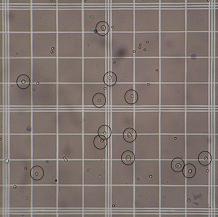Aby wyświetlić tę treść, wymagana jest subskrypcja JoVE. Zaloguj się lub rozpocznij bezpłatny okres próbny.
Method Article
Culture of myeloid dendritic cells from bone marrow precursors
W tym Artykule
Podsumowanie
This video demonstrates the procedure for differentiating myeloid dendritic cells from mouse bone marrow. Isolation of mouse tibia and femur, and processing of bone marrow are demonstrated. Pictures demonstrating cell morphology before and after differentiation, and figures depicting cell phenotype and IL-12 production following maturation using CpG are shown.
Streszczenie
Protokół
This protocol has been adapted from Lutz et al.1
Harvest and processing of bone marrow
- Isolation of the tibia and femur: Euthanize the donor mouse and spray the legs with 70% ethanol. Grasp the first ankle firmly with blunt forceps and begin to cut away the skin and underlying musculature to expose the tibia. To avoid damaging the bone, cut slowly and parallel to the tibia, leaving the knee joint intact.
To clean the femur, immobilize the knee joint by grasping with blunt forceps. Clean away the musculature with a pair of sharp scissors and curved forceps. Continue upward until the hip joint is exposed and scissors can be placed between the head of the femur and the hip joint. Remove the bones by cutting between femur and hip joint and place into phosphate buffered saline (PBS) on ice. - Removal of bone marrow: Clean remaining musculature from the bones using scissors and curved forceps. Cut off the epiphyses of each bone and locate the center cavity. Using a 10mL syringe loaded with PBS and a 25G0.5” needle, flush the bone marrow into a non-tissue coated petri dish.
- Processing of bone marrow: Use the rubber end of the plunger from a 1mL syringe to dissociate the bone marrow into a single-cell suspension (use an up and down, not scraping motion). Collect bone marrow in a conical falcon tube, and rinse residual bone marrow with PBS.
Culture of dendritic cells
- Resuspend cells in DC media and count DC precursors on a hemocytometer (Figure 1). You will see cells of varying sizes; the DC precursors are the largest and brightest. Differentially count only these cells. From two femurs and two tibias of a wild-type C57Bl/6 mouse (6-8 weeks old), you should expect between 25-40 x 106 total DC precursors.

Figure 1 - Culture cells at a density of 2 x 105 DC precursors/mL in DC media supplemented with 40 ng/mL recombinant murine GM-CSF. Plate cells in non-tissue-coated polystyrene petri plates.
Add media (day 3)
To refresh the media, add half of the total volume of fresh media supplemented with 40 ng/mL GM-CSF.
Replace one third of the media (day 6) and maturation
To refresh the media, carefully remove one third of the total volume of media and replace this volume with fresh DC media supplemented with 40 ng/mL GM-CSF on day 6 of culture.
If desired, dendritic cells can be stimulated for maturation using cytokines or toll-like receptor ligands. In the video, DCs were matured by overnight stimulation with 5 ng/mL CpG.
Harvest of dendritic cells
DC culture is complete (Figure 2). Cells will be both in suspension and loosely adhered to the plate. Adhered cells can be removed by scraping the dish with a tissue culture scraper and rinsing with PBS. The total number of cells will increase 5-8 fold during the week-long culture and differentiation period, therefore, expect to harvest 1-1.6 x 106 cells/mL.
Figure 2
Reagents
- DC media
- RPMI-1640 media, supplemented with:
- 10% Fetal bovine serum
- 100 IU/mL penicillin
- 100 μg/mL streptomycin
- 1%L-glutamine
- 0.1% 2-mercaptoethanol
- 1X non-essential amino acids
- 1X sodium pyruvate
- Recombinant murine GM-CSF
- rmGM-CSF (Peprotech inc, New Jersey, catalogue no. 315-03)
Dyskusje
DCs are useful for studies of innate and adaptive immune interactions, and can be employed as a vaccine vector. In this video, we have demonstrated the steps to isolate bone marrow and differentiate myeloid dendritic cells in vitro. Following the culture period, these cells can be visualized microscopically both as adherent cells, which often possess dendrites, and non-adherent round cells. The DCs can be further manipulated for antigen presentation by pulsing with antigen or stimulated for cytokine production and costim...
Podziękowania
JB is supported by studentships from the Natural Sciences and Engineering Research Council (NSERC). Support for this project has been provided by the Canadian Institutes of Health Research, Grant MOP-67066.
Materiały
| Name | Company | Catalog Number | Comments | |
| recombinant murine GM-CSF | Reagent | Peptrotech | 315-03 |
Odniesienia
- Lutz, M. B., Kukutsch, N., Ogilvie, A. L., Rossner, S., Koch, F., Romani, N., Schuler, G. An advanced culture method for generating large quantities of highly pure dendritic cells from mouse bone marrow. J. Immunol. Methods. 223, 77-92 (1999).
- Gilboa, E. DC-based cancer vaccines. J. Clin. Invest. 117, 1195-1203 (2007).
Przedruki i uprawnienia
Zapytaj o uprawnienia na użycie tekstu lub obrazów z tego artykułu JoVE
Zapytaj o uprawnieniaPrzeglądaj więcej artyków
This article has been published
Video Coming Soon
Copyright © 2025 MyJoVE Corporation. Wszelkie prawa zastrzeżone